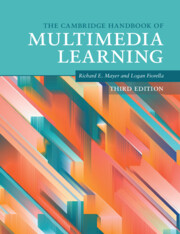Book contents
- The Cambridge Handbook of Multimedia Learning
- The Cambridge Handbook of Multimedia Learning
- Copyright page
- Contents
- Figures
- Tables
- Contributors
- Preface
- Acknowledgments
- Part I Background
- Part II Theoretical Foundations
- Part III Basic Principles of Multimedia Learning
- Part IV Principles for Reducing Extraneous Processing in Multimedia Learning
- Part V Principles for Managing Essential Processing in Multimedia Learning
- Part VI Principles Based on Social and Affective Features of Multimedia Learning
- Part VII Principles Based on Generative Activity in Multimedia Learning
- Part VIII Multimedia Learning with Media
- 37 Multimedia Learning with Cognitive Tutors
- 38 Multimedia Learning with Animated Pedagogical Agents
- 39 Multimedia Learning with Simulations
- 40 Multimedia Learning with Computer Games
- 41 Multimedia Learning with Instructional Video
- 42 Multimedia Learning in Virtual and Mixed Reality
- 43 Multimedia Learning with Visual Displays
- 44 Multimedia Learning from Multiple Documents
- 45 Multimedia Learning in e-Courses
- 46 Principles for Educational Assessment with Multimedia
- Author Index
- Subject Index
- References
41 - Multimedia Learning with Instructional Video
from Part VIII - Multimedia Learning with Media
Published online by Cambridge University Press: 19 November 2021
- The Cambridge Handbook of Multimedia Learning
- The Cambridge Handbook of Multimedia Learning
- Copyright page
- Contents
- Figures
- Tables
- Contributors
- Preface
- Acknowledgments
- Part I Background
- Part II Theoretical Foundations
- Part III Basic Principles of Multimedia Learning
- Part IV Principles for Reducing Extraneous Processing in Multimedia Learning
- Part V Principles for Managing Essential Processing in Multimedia Learning
- Part VI Principles Based on Social and Affective Features of Multimedia Learning
- Part VII Principles Based on Generative Activity in Multimedia Learning
- Part VIII Multimedia Learning with Media
- 37 Multimedia Learning with Cognitive Tutors
- 38 Multimedia Learning with Animated Pedagogical Agents
- 39 Multimedia Learning with Simulations
- 40 Multimedia Learning with Computer Games
- 41 Multimedia Learning with Instructional Video
- 42 Multimedia Learning in Virtual and Mixed Reality
- 43 Multimedia Learning with Visual Displays
- 44 Multimedia Learning from Multiple Documents
- 45 Multimedia Learning in e-Courses
- 46 Principles for Educational Assessment with Multimedia
- Author Index
- Subject Index
- References
Summary
Video is one of the most popular ways to deliver instruction, yet researchers are only beginning to understand how to design effective video lessons. This chapter explores: (a) how to present the learning material (multimedia design), (b) how to present the instructor (instructor presence), and (c) how to foster student engagement (generative activity). The empirical evidence suggests videos are most effective when they adhere to basic multimedia design principles (e.g., coherence, redundancy, or segmenting), when they are sensitive to the benefits and boundaries of specific instructor presence features (e.g., the instructor’s face, eyes, and hands), and when they explicitly prompt learners to retrieve and make sense of the learning material (e.g., practice testing or self-explaining). Future research is needed to specify boundary conditions and apply video design principles to more authentic educational contexts.
Keywords
- Type
- Chapter
- Information
- The Cambridge Handbook of Multimedia Learning , pp. 487 - 497Publisher: Cambridge University PressPrint publication year: 2021
References
- 5
- Cited by



